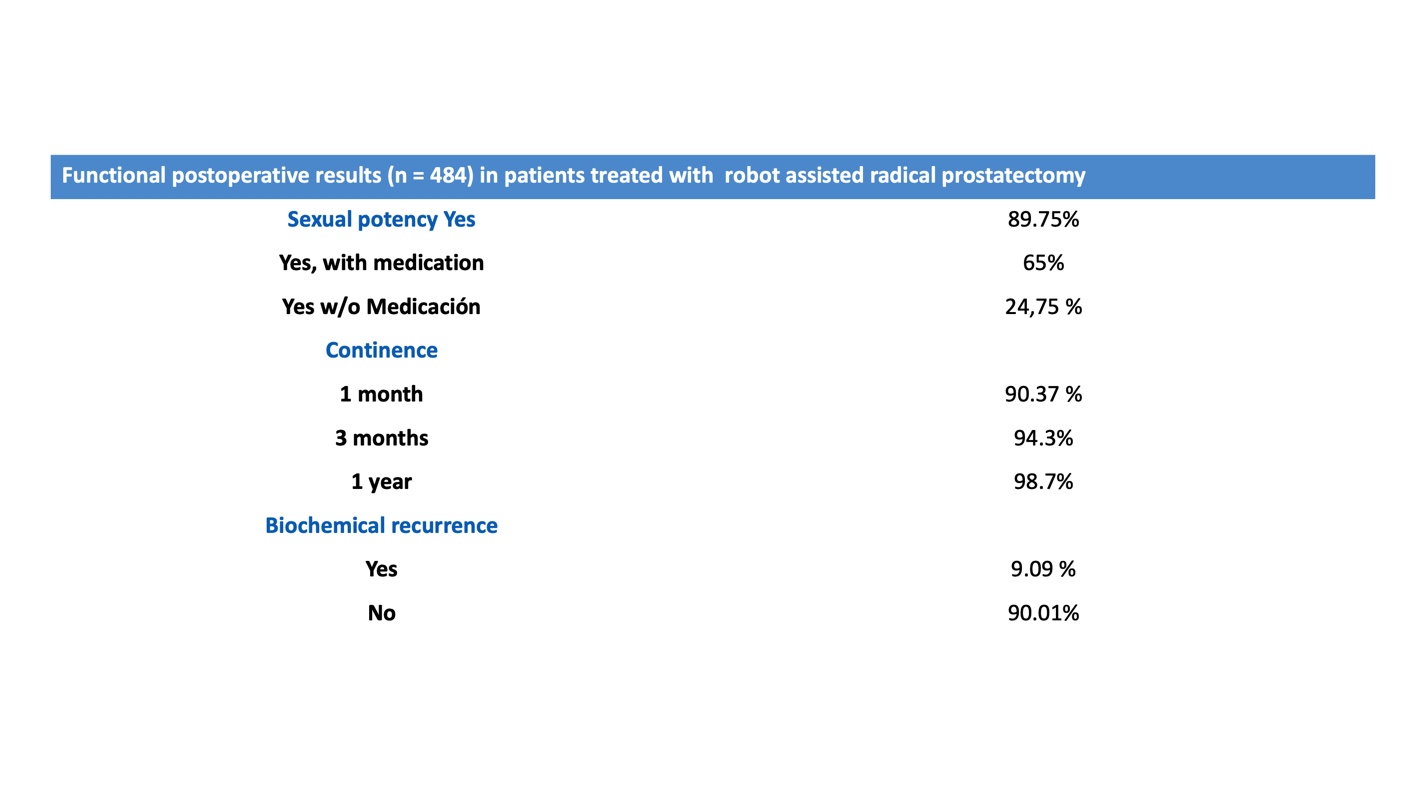Back
Poster, Podium & Video Sessions
Video
V07: Prostate, Penile, Testis & Misc. Oncology I
V07-08: Feasibility and Clinical Outcomes of Robot-Assisted Radical Prostatectomy by Lateral Approach
Sunday, May 15, 2022
8:10 AM – 8:20 AM
Location: Video Abstracts Theater
Javier Reinoso Elbers*, Moises Rodríguez Socarras, Luis Llanes González, Juan Gómez Rivas, Diego Carrion Monsalve, Julio Fernández del Álamo, Madrid, Spain, Richard Gaston, Bourdeaux, France, Fernando Gómez Sancha, Madrid, Spain
- JR
Video Presenter(s)
Introduction: Minimally invasive surgery for prostate cancer is constantly evolving.
The development of technology and robotic surgery has contributed to a better understanding of prostate anatomy, allowing patients to receive an individualized treatment.
The objective is to present the results of 484 consecutive patients treated of prostate cancer with robot assisted radical prostatectomy (RARP) by right lateral access with preservation of the pubovesical complex (PVC) and some technical modifications observed in the last years.
Methods: 484 specimens of patients undergoing robot assisted radical prostatectomy between January 2016 and May 2021 were studied. Demographic, preoperative, intraoperative, post-operative, oncologic and functional outcomes at 1½ year follow up were analyzed.
Surgical technique :The principles of bladder neck preservation, tension and energy-free dissection of the bundles, seminal vesicle sparing, as well as PVC and Santorini´s plexus preservation are described. A lateral running suture is performed to restore continuity of the urinary tract.
Results: Mean surgical time was 146.18 min (SD +/- 47.22). The complete lateral access and PVC preservation was feasible in 93.87% of cases. Mean hospital stay was 2,5 days (IQR+/-0.97). Complication rate was 6.53% (Clavien-Dindo III/IV 2.6%).
Clinically significant prostate cancer (ISUP =2) rate was 91%. Positive surgical margins (PSM) rate was 25% (95,02 %focal; 4.98% extensive). Biochemical recurrence at 1½ year follow up was 9.09%.
Total continence rate at 1,3,12 months was 90.37%,94.3% and 98.7%. Potency rate was 89.75% (24.75% without medication) at 1 year follow up.
Conclusions: Lateral approach with direct access to the seminal vesicle is a safe technique that provide excellent functional and oncological results.
It is a reproducible technique even in high risk cases and patients with previous surgeries.
Very high risk cases may require tailored surgery and variations of the technique.
Source of Funding: None


The development of technology and robotic surgery has contributed to a better understanding of prostate anatomy, allowing patients to receive an individualized treatment.
The objective is to present the results of 484 consecutive patients treated of prostate cancer with robot assisted radical prostatectomy (RARP) by right lateral access with preservation of the pubovesical complex (PVC) and some technical modifications observed in the last years.
Methods: 484 specimens of patients undergoing robot assisted radical prostatectomy between January 2016 and May 2021 were studied. Demographic, preoperative, intraoperative, post-operative, oncologic and functional outcomes at 1½ year follow up were analyzed.
Surgical technique :The principles of bladder neck preservation, tension and energy-free dissection of the bundles, seminal vesicle sparing, as well as PVC and Santorini´s plexus preservation are described. A lateral running suture is performed to restore continuity of the urinary tract.
Results: Mean surgical time was 146.18 min (SD +/- 47.22). The complete lateral access and PVC preservation was feasible in 93.87% of cases. Mean hospital stay was 2,5 days (IQR+/-0.97). Complication rate was 6.53% (Clavien-Dindo III/IV 2.6%).
Clinically significant prostate cancer (ISUP =2) rate was 91%. Positive surgical margins (PSM) rate was 25% (95,02 %focal; 4.98% extensive). Biochemical recurrence at 1½ year follow up was 9.09%.
Total continence rate at 1,3,12 months was 90.37%,94.3% and 98.7%. Potency rate was 89.75% (24.75% without medication) at 1 year follow up.
Conclusions: Lateral approach with direct access to the seminal vesicle is a safe technique that provide excellent functional and oncological results.
It is a reproducible technique even in high risk cases and patients with previous surgeries.
Very high risk cases may require tailored surgery and variations of the technique.
Source of Funding: None



.jpg)
.jpg)